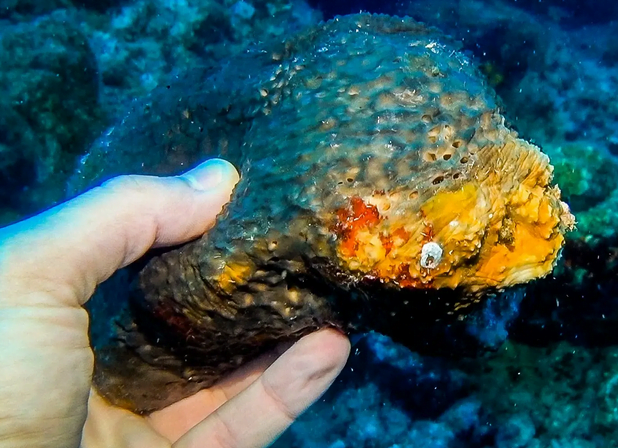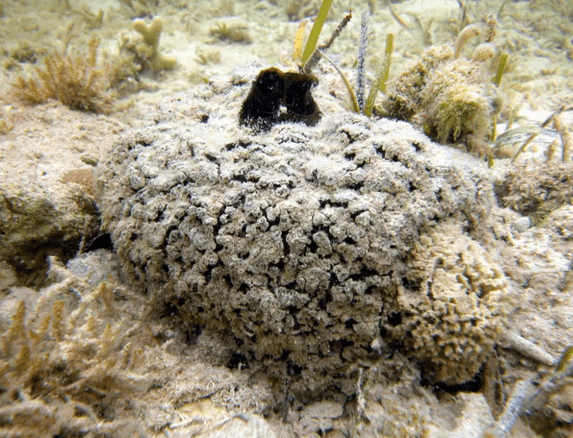Beneath the depths of our oceans lies an extraordinary wonder – the sea sponge. Often underestimated and used for bathing, these unassuming creatures are vital to marine ecosystems and medical practices. Join us as we delve into the captivating world of sea sponges, revealing interesting facts about their astounding biodiversity and essential role in oceanic health.
Clade: Myriazoa
Phylum: Porifera
1. Sea sponges are animals
Sea sponges, which fall under the phylum Porifera, may look like plants, but they are, in fact, fascinatingly simple multi-celled animals. Instead of being equipped with tissues and organs like most animals, they rely on specialized cells that serve distinct purposes, such as filtering water for feeding, digestion, waste elimination, and reproduction. These species operate without a brain, mouth, eyes, or central nervous system. They cannot think, feel pain, or give you any response when being touched.
Intriguingly, their one-of-a-kind skeleton consists of spicules crafted from a diverse array of materials such as calcium, silica, or calcium carbonate, all reinforced by the remarkable protein known as spongin. These spicules play important roles in maintaining the sponge’s structural unity and helping scientists to distinguish different sponge species.
On their surface, there are many pores or holes. These minute openings serve as vital components in the sponge’s intricate filtration mechanism, as they deftly pull in water and extract precious nutrients from its flow.
Over 6,000 distinct types of sea sponges have been identified in the ocean, presenting a vibrant tapestry of colors, shapes, and sizes.

These incredible marine organisms can range from tiny creatures measuring less than half an inch to colossal specimens reaching a towering 11 feet in height. Among them, a colossal sponge found off the coast of Hawaii in 2015 stands as the largest sea sponge in the world with a size of 12 feet by 7 feet. This deep sponge hasn’t yet been officially named.
They exhibit a diverse array of appearances. While some species mimic crust-like formations hugging rocks, others take on the appearance of encrustations, rounded masses, branched structures, or even tall vases. Each one of them is an awe-inspiring creation of nature’s boundless imagination. These species also come in various colors, from dark shades like brownish, black, or drab to brighter hues like orange, blue, red, yellow, purple, or green.

Some natural sponge species are sheep’s wool sponge, honeycomb bath sponge, deep-sea glass sponge, Caribbean silk sponge, Caribbean grass sponge, ping-pong tree sponge, or antarctic sea sponge.
2. Habitat
Sea sponges are found in oceans around the world. While their primary residence lies within the vast oceans, some species have adapted to thrive in the unique conditions of brackish water or freshwater. These species exhibit high sensitivity to air, making it challenging for them to endure extended periods out of the water.
These extraordinary creatures display an impressive adaptability to diverse locations and habitats, spanning from the icy waters of the Arctic to the balmy tropical oceans, from vibrant coral reefs to tranquil shallow intertidal zones to the profound ocean depths. Nonetheless, they tend to stay away from places with vigorous currents or turbulent waves. They prefer pristine waters rather than murky environments since sediments and dirt can fill their pores, causing them to die.

Unlike sea lilies or sea pens, sea sponges can’t swim or move. They are firmly anchored to the ocean floor or other surfaces, like coral, seabed, rocks, shells, and even fellow marine creatures. This is the reason why sponges are often mistaken for plants.
3. Diet
Sea sponges lack a mouth for eating. To eat, they utilize small pores known as ostia to take in water. As water flows through the sponge’s porous outer surface, it obtains essential food and oxygen. Within the sponge, intricate channels are adorned with fine hair-like structures called flagella. These flagella generate currents, effectively eliminating waste from the sponge’s cells while simultaneously capturing and containing nourishment.
Sea sponges are not picky eaters; they consume whatever the ocean currents bring their way, such as organic matter, viruses, bacteria, detritus, plankton, and small organisms. The sponges residing close to vibrant coral reefs are fortunate to indulge in an abundance of nutrient-rich particles.

Nevertheless, when living in waters with limited food resources, certain sponges adapt to carnivorous tendencies and acquire ingenious ways to secure their prey, often capturing crustaceans or other small animals. These carnivores may employ tactics like barbed spicules or sticky threads to ensnare their unsuspecting victims.
Interestingly, sea sponges don’t have many predators due to their unappetizing nature for most marine animals. Through evolutionary adaptations, they have developed potent defense mechanisms, such as the secretion of toxins and a spicule structure, which repel fish and turtles from eating them. These natural deterrents render sea sponges less appealing and challenging to digest. Besides, they can swiftly regenerate when subjected to wounds.

Only a few species can eat them, like certain nudibranchs, the Hawksbill sea turtle, starfish, and some tropical fish. Certain nudibranchs have developed a fascinating survival strategy – they not only consume sponges but also assimilate their toxins. Subsequently, these nudibranchs employ the absorbed toxins as a potent weapon for self-defense.
4. They can hurt you
The vast majority of sea sponges pose no threat, and if you happen to come into contact with them, it’s typically harmless and might cause only mild abrasion. Nonetheless, in the depths of the ocean, there exist a select few species, such as the poison-bun sponge, red-beard sponge, and fire sponge, that synthesize crinitoxins and can induce irritation and dermatitis.
Interestingly, initial contact with these toxin-producing sponges may go unnoticed by most individuals. However, after a significant lapse of time, ranging from hours to days, a sensation of burning, stinging, or itching may gradually emerge. This discomfort may be accompanied by redness, varying degrees of pain, joint discomfort, localized inflammation, and swelling.
5. They can live for thousands of years
Sea sponges are remarkable in their reproductive strategies, reproducing both sexually and asexually. When it comes to sexual reproduction, many sponges are hermaphroditic, enabling them to switch between 2 genders: male and female roles. This unique trait enables them to produce eggs and sperm at different times, allowing each adult to undertake either the female or male function during the reproductive journey.
In the process of sexual reproduction, the male marine sponge liberates its sperm into the surrounding water, where it becomes carried away by currents. Over time, the sperm successfully finds its way to the female sponge, where internal fertilization of eggs occurs. As a result, tiny larvae emerge from the female sponge and drift as plankton until they locate an appropriate surface to adhere to, becoming their permanent home.

Conversely, sea sponges engage in asexual reproduction through genetic cloning, a fascinating process. Their reproductive method entails the formation of buds—compact clusters of diverse cells encased in a protective layer. These buds can separate from the parent sponge and meander independently until they encounter a fitting surface to settle on, metamorphosing into fully-fledged sponges.
The longevity of sea sponges is awe-inspiring. Their lifespans span hundreds, even thousands of years. Certain species boast a remarkable 200-year lifespan, while others astonishingly endure for up to 5000 years. The oldest fossiled sea sponge is about 890 million years old.
6. They’re ecosystem engineers
Sponges hold immense importance within coral reef ecosystems, actively contributing to nutrient cycles. Their exceptional filtration capabilities enable the removal of substantial quantities of bacteria and particles from the water. This process transforms suspended particles and dissolved substances into nourishment for various marine organisms while facilitating the recycling of carbon, nitrogen, and phosphorous to avert detrimental alterations in the ecosystem.
Their ability to filter substantial amounts of water every day, varying according to their species, plays a vital role in preserving the overall water quality.

Besides, these species provide shelter and food for crustaceans and fish. Under certain circumstances, sponges have the remarkable ability to foster biodiversity hotspots within environments that would otherwise be considered inhospitable.
Furthermore, sponges have lots of benefits for humans. They contain a variety of compounds that exhibit promising prospects in the field of medicine, encompassing gastrointestinal, respiratory, anti-inflammatory, cardiovascular, antitumor, and antibiotic properties. Beyond their medical applications, these compounds also hold considerable potential in the realm of biotechnology.
Researchers believe that these sea creatures hold the potential to pave the way for groundbreaking medications to combat severe illnesses, including viral infections, inflammatory conditions, malaria, and cancer.
References:
- Thoughtco.com
- Spongean.com

